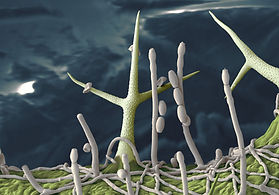
Stergiopoulos Lab
UNIVERSITY OF CALIFORNIA DAVIS
PLANT PATHOLOGY
The genomics of host-shift speciation in Dothideomycete plant pathogens.
Understanding how fungal pathogens emerge and are able to readily adapt and exploit new hosts or host genotypes, is critical in the face of globalization and changing ecosystems. The goals within this theme of our research are to determine the genomic changes associated with speciation and shifts in virulence spectra of select Dothideomycete plant pathogens, and to identify their pathogenic core that can be exploited in plant-breeding and genetic engineering programs to combat plant diseases. To achieve these goals, we employ comparative, population and evolutionary genomics, and transcriptomics to detect in a select set of Dothideomycete fungi patterns of pathogen evolution associated with host-shifts and virulence-jumps. These studies are further complemented by functional genomics, which examine the contribution to virulence of selected, based on our comparative genome analyses, candidate virulence-associated genes.
RESEARCH
Structural elucidation of pathogen effectors and of plant immune receptors.
Through our studies we have identified a large number of core effectors, which despite their low sequence homology, are often collectively recognized by single cognate immune receptors. This contrasts the current perspective of specificity in effector perception and suggests that resistance proteins recognizing core effectors could function as pattern recognition receptors (PRRs) that mediate broad-spectrum resistance. Consequently, resistance proteins that perceive core effectors are important targets for breeding or genetic engineering programs, but the molecular basis for the pleiotropic recognition of effectors by single cognate immune receptors still remains poorly understood. In this theme, we utilize structural biology in order to obtain a molecular-level understanding of effector/immune receptor interactions, by determining the crystal structures of effectors and cognate receptors as separate proteins and in a complex. Such knowledge could be consequently used for engineering immune receptors with broaden recognition specificities.
Evolutionary dynamics and functional significance for orgnismal biology and disease of fungal effector proteins.
Microbes secrete numerous proteins to adapt to as well as to alter their environment. The secretome, or extracellular proteome, has an essential role in microbial physiology, survival and communication with each other and the environment. We are focusing on the computational, biochemical, and functional characterization of fungal secretomes with an emphasis on effector proteins. These low molecular weight proteins are secreted by microbes during pathogenesis to suppress or evade the host immune system and thus, play a major role in defining pathogenicity. Most fungal effectors were until recently assumed to be species-specific that originated late in a pathogen’s evolutionary history to facilitate disease on a specific host. However, research in our lab and elsewhere has revealed the presence of abundant homologous “core” effector proteins across different fungal species, thus challenging the “species-specific” paradigm in plant-pathogen interactions. In our research, we study the function and cellular targets of core effector proteins, their contribution to virulence, their recognition by single cognate immune receptors, and their evolution on a macro- and micro-evolutionary scale.
RNAi mediated control of afltoxin production in Aspergillus flavus and Aspergillus parasiticus.
Aflatoxins are a group of highly toxic and carcinogenic polyketide mycotoxins that are produced mainly by members of the fungal genus Aspergillus. These mycotoxins pose serious health hazards to humans and domestic animals, as they frequently contaminate agricultural commodities, including crops, dairy products, meat, and eggs. The goal in our work, is to use RNA interference (RNAi) as a tool to investigate and modulate mycotoxin production in fungi of agronomic importance. Our main focus is currently on reducing Aspergillus growth and aflatoxin production in maize and peanut. As part of this project, we are also studying double stranded RNA (dsRNA)-mediated posttranscriptional gene silencing processes in fungi at the molecular and cellular level. To accomplish these goals, we employ a wide range of approaches, including RNA functional studies, use of reporter transgenes, fluorescence spectroscopy, fungal genetics, fungal transformations, and others.
Molecular aspects and evolutionary dynamics of bacterial-fumngal biointercations.
The use of microbial antagonists, such as biocontrol bacteria for managing fungal plant diseases, has gained substantial popularity over the last couple of decades as an alternative to chemical control. However, antagonistic interactions between biocontrol agents and plant pathogens can exert significant selection pressure on the targeted organisms. Our objective is to provide a theoretical framework of how the use of biocontrol bacteria against fungi in an agronomical setting affects the evolutionary dynamics of the two interacting partners. Using experimental evolution we are investigating the type, magnitude, and direction of evolutionary changes induced over time in the two interacting partners as a result of their coevolution. In addition, we are studying at the physiological and molecular level the precise mode of action of selected biocontrol agents towards fungi.

Molecular mechanisms of fungicide resistance.
We are investigating whether the continuous use of azole and strobilurin (QoI) fungicides against the tomato powdery mildew fungi Leveillula taurica, Oidium neolycopersici, and Oidium lycopersici has sparked the appearance of resistant strains in California, and further determine their dispersal across the state. We further examine the molecular mechanisms responcible for resistance development by cloning and characterizing the CYP51 and the mitochondrial cytochrome b (cytb) genes of these fungi which encode the enzymatic targets of azole and strobilurin fungicides, respectively.



Molecular Mechanisms of Fungal
Pathogenesis on Plants:
From Systems Biology to Translational Research







Copyright © Ioannis Stergiopoulos. All rights reserved.